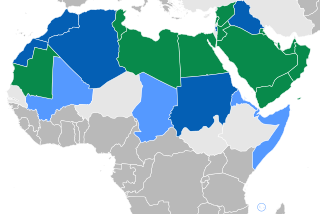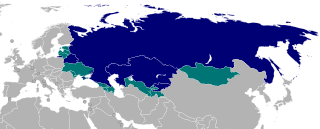Related Research Articles

Arabic is a Central Semitic language of the Afroasiatic language family spoken primarily in the Arab world. The ISO assigns language codes to 32 varieties of Arabic, including its standard form of Literary Arabic, known as Modern Standard Arabic, which is derived from Classical Arabic. This distinction exists primarily among Western linguists; Arabic speakers themselves generally do not distinguish between Modern Standard Arabic and Classical Arabic, but rather refer to both as al-ʿarabiyyatu l-fuṣḥā or simply al-fuṣḥā (اَلْفُصْحَىٰ).

French is a Romance language of the Indo-European family. Like all other Romance languages, it descended from the Vulgar Latin of the Roman Empire. French evolved from Gallo-Romance, the Latin spoken in Gaul, and more specifically in Northern Gaul. Its closest relatives are the other langues d'oïl—languages historically spoken in northern France and in southern Belgium, which French (Francien) largely supplanted. French was also influenced by native Celtic languages of Northern Roman Gaul like Gallia Belgica and by the (Germanic) Frankish language of the post-Roman Frankish invaders. Today, owing to the French colonial empire, there are numerous French-based creole languages, most notably Haitian Creole. A French-speaking person or nation may be referred to as Francophone in both English and French.

Modern Standard Hindi, commonly referred to as Hindi, is a member of the Indo-Aryan language group within the Indo-European language family. Hindi is considered a Sanskritised register of the Hindustani language, which itself is based primarily on the Khariboli dialect of Delhi and neighbouring areas. It is the preferred official language of India, although much national business is also done in English and the other languages recognized in the Indian constitution. It is the official language of India alongside English in nine states and three union territories and an additional official language in three other states. Hindi is also one of the 22 scheduled languages of the Republic of India.

The Indo-European languages are a language family native to the northern Indian subcontinent, the overwhelming majority of Europe, and the Iranian plateau. Some European languages of this family—English, French, Portuguese, Russian, Dutch, and Spanish—have expanded through colonialism in the modern period and are now spoken across several continents. The Indo-European family is divided into several branches or sub-families, of which there are eight groups with languages still alive today: Albanian, Armenian, Balto-Slavic, Celtic, Germanic, Hellenic, Indo-Iranian, and Italic; another nine subdivisions are now extinct.
Phonetics is a branch of linguistics that studies how humans produce and perceive sounds or, in the case of sign languages, the equivalent aspects of sign. Linguists who specialize in studying the physical properties of speech are phoneticians. The field of phonetics is traditionally divided into three sub-disciplines on questions involved such as how humans plan and execute movements to produce speech, how various movements affect the properties of the resulting sound or how humans convert sound waves to linguistic information. Traditionally, the minimal linguistic unit of phonetics is the phone—a speech sound in a language which differs from the phonological unit of phoneme; the phoneme is an abstract categorization of phones and it is also defined as the smallest unit that discerns meaning between sounds in any given language.

Russian is an East Slavic language belonging to the Balto-Slavic branch of the Indo-European language family. It is one of the four extant East Slavic languages, and is the native language of the Russians. It was the de facto and de jure official language of the former Soviet Union. Russian has remained an official language of the Russian Federation, Belarus, Kazakhstan, Kyrgyzstan, and Tajikistan, and is still commonly used as a lingua franca in Ukraine, Moldova, the Caucasus, Central Asia, and to a lesser extent in the Baltic states and Israel.

A courtesy name, also known as a style name, is an additional name bestowed upon individuals at adulthood, complementing their given name. This tradition is prevalent in the East Asian cultural sphere, particularly in China, Japan, Korea, and Vietnam. Courtesy names are a marker of adulthood and were historically given to men at the age of 20, and sometimes to women upon marriage.
The voiceless labiodental plosive or stop is a consonant sound produced like a [p], but with the lower lip contacting the upper teeth, as in [f]. This can be represented in the IPA as ⟨p̪⟩. A separate symbol not recognized by the IPA that was occasionally seen, especially in Bantu linguistics, is the qp ligature⟨ȹ⟩.
Shubi is a Bantu language spoken by the Shubi people in north-western Tanzania. It may use labiodental plosives, as phonemes, rather than as allophones of. Peter Ladefoged wrote:

English is a West Germanic language in the Indo-European language family, whose speakers, called Anglophones, originated in early medieval England on the island of Great Britain. The namesake of the language is the Angles, one of the ancient Germanic peoples that migrated to Britain. It is the most spoken language in the world, primarily due to the global influences of the former British Empire and the United States. English is the third-most spoken native language, after Mandarin Chinese and Spanish; it is also the most widely learned second language in the world, with more second-language speakers than native speakers.

The Hlubi people or AmaHlubi are an AmaMbo ethnic group native to Southern Africa, with the majority of population found in Gauteng, Mpumalanga, KwaZulu-Natal and Eastern Cape provinces of South Africa.
The Great Lakes Bantu languages are a group of Bantu languages of East Africa. They are also known as Lacustrine Bantu and Bantu zone J. They were recognized as a group by the Tervuren team, who posited them as an additional zone to Guthrie's largely geographic classification of Bantu.
Fuliiru, or Kifuliiru, is a Great Lakes Bantu language spoken by the Fuliiru people (Bafuliiru), also known as the Fuliru, who live north and west of the town of Uvira in Uvira Territory, South Kivu Province in the far eastern part of the Democratic Republic of the Congo (DRC). It is closely related to Kinyindu.
Shubi may refer to:

The Changzhou comb is a type of hand-painted comb produced in Changzhou, Jiangsu, China. In China, combs are called shubi (梳篦). The combs were originally made for use by royalty and have been in production for over 2000 years.
Spurious languages are languages that have been reported as existing in reputable works, while other research has reported that the language in question did not exist. Some spurious languages have been proven to not exist. Others have very little evidence supporting their existence, and have been dismissed in later scholarship. Others still are of uncertain existence due to limited research.

Dalia Friedland is an Israeli actress and singer.
Subi is a minor Bantu language of Tanzania, spoken on the southern shore of Lake Victoria. It is not listed in most sources, including Linguasphere. It has at times been confused with Shubi, though the two are not especially closely related.
SUJ or suj may refer to:

Shubi, also called as zhi, is a generic term used for Chinese combs in China, which includes thick-teeth comb shu and thin-teeth comb bi. Shubi originated about 6000 years ago in China during the late Neolithic period. Some Chinese combs dating from the Shang dynasty were found in the Tomb of Fuhao. In ancient China, Chinese combs had a high special status, a high artistic value, was an important form of hair ornament in Chinese history. Chinese comb also had and continues to hold unique cultural meaning and emotional value. Chinese combs in China were not used only for grooming purposes, they were also used holding and decorating hair. Both Chinese men and women wore decorative combs in their hair in ancient China. Chinese women often wore combs and fine-tooth combs in their hair buns. Chinese comb-making was also an important form of traditional Chinese art and business industry.